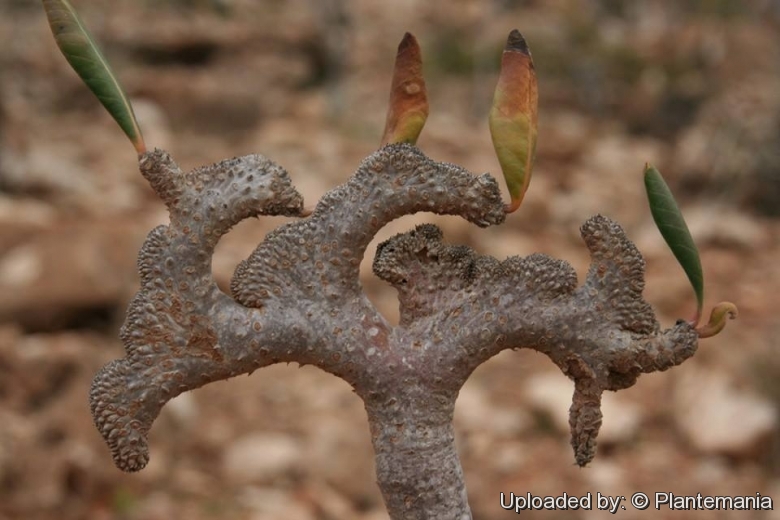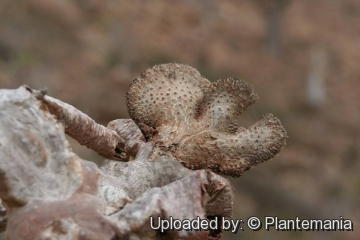Accepted Scientific Name: Adenium obesum Roem. & Schult.
Syst. Veg., ed. 15 bis [Roemer & Schultes] 4: 411. 1819

Adenium obesum subs. socotranum f. cristata Photo by: © Plantemania
A rare naturally occurring cristation in habitat at Socotra.
Origin and Habitat: Adenium obesumSN|129]]SN|116]] ssp. socotranum (Adenium socotranumSN|116]]SN|129]]) is endemic from from the isolated island of Socotra in the Indian Ocean south of the Arabian peninsula and east of the Horn of Africa.
Synonyms:
See all synonyms of Adenium obesum
Description: The standard Socotran desert rose, Adenium obesumSN|116]]SN|116]] subs. socotranum, long popular because of its large size and unique architecture is, perhaps, the more famous of all adeniums. It is the giant of the genus, forming a massive conical trunk/caudex several metres tall and up to 2.4 m in diameter, the whole plant up to 3,5 meter in height. It resembles a miniature baobab with surrealistic forms. Some turn into tall trees while some may grow with their swollen bases more flat on the soil. These beautiful crested forms (Adenium obesumSN|116]]SN|116]] subs. socotranum f. cristata) are very rare in collection and highly priced for their odd shape and size.
Subspecies, varieties, forms and cultivars of plants belonging to the Adenium obesum group
 Adenium arabicum Balf.f.: is similar in appearance to Adenium obesum, but creates a massive, more squat and fat caudex and has larger thick fleshy leaves. Distribution: Yemen and Saudi Arabia.
Adenium arabicum Balf.f.: is similar in appearance to Adenium obesum, but creates a massive, more squat and fat caudex and has larger thick fleshy leaves. Distribution: Yemen and Saudi Arabia. Adenium dhofarense Rzepecky: Has large, leathery and glossy leaves and very small flowers. Distribution: Dhofar coast (Oman) and adjacent mountains of Yemen.
Adenium dhofarense Rzepecky: Has large, leathery and glossy leaves and very small flowers. Distribution: Dhofar coast (Oman) and adjacent mountains of Yemen.  Adenium obesum Roem. & Schult.: The trunk will get up to one meter in diameter, and the plant will grow op to five meters.
Adenium obesum Roem. & Schult.: The trunk will get up to one meter in diameter, and the plant will grow op to five meters.- Adenium obesum f. albiflorum Lodé
 Adenium obesum subs. boehmianum (Schinz) G.D.Rowley: The flowers are similar to those of A. swazicum but the leaves are broader pale grayish-green.
Adenium obesum subs. boehmianum (Schinz) G.D.Rowley: The flowers are similar to those of A. swazicum but the leaves are broader pale grayish-green. Adenium obesum subs. oleifolium (Stapf) G.D.Rowley: succulent shrublet 12-40 cm high from a subterranean rootstock. It has long, narrow leaves frequently folded along the midrib. Distribution: Botswana, Namibia and S. Africa.
Adenium obesum subs. oleifolium (Stapf) G.D.Rowley: succulent shrublet 12-40 cm high from a subterranean rootstock. It has long, narrow leaves frequently folded along the midrib. Distribution: Botswana, Namibia and S. Africa. Adenium obesum subs. socotranum (Vierh.) Lavranos: It is the giant of the genus, forming a massive conical trunk/caudex several metres tall and up to 2.4 m in diameter. It resembles a miniature baobab.
Adenium obesum subs. socotranum (Vierh.) Lavranos: It is the giant of the genus, forming a massive conical trunk/caudex several metres tall and up to 2.4 m in diameter. It resembles a miniature baobab. Adenium obesum subs. socotranum f. cristata hort.: crested form.
Adenium obesum subs. socotranum f. cristata hort.: crested form.- Adenium obesum subs. somalense (Balf.f.) G.D.Rowley
 Adenium obesum subs. swazicum (Stapf) G.D.Rowley: It is a dwarf shrub, up to 30 cm high, with an enlarged succulent stem with few branches. The caudex is evident only in young specimens.
Adenium obesum subs. swazicum (Stapf) G.D.Rowley: It is a dwarf shrub, up to 30 cm high, with an enlarged succulent stem with few branches. The caudex is evident only in young specimens. Adenium somalense var. crispum Chiov.: is a dwarf form of A. somalense (less than 30 cm tall) with white flowers heavily striped with red or completely red and a large underground napiform caudex. Distribution: Coast of southern Somalia.
Adenium somalense var. crispum Chiov.: is a dwarf form of A. somalense (less than 30 cm tall) with white flowers heavily striped with red or completely red and a large underground napiform caudex. Distribution: Coast of southern Somalia.
Notes: The cause of cresting is not fully explained; biologists disagree as to why some saguaros grow in this unusual form. Some speculate that it is a genetic mutation. Others say it is the result of lightning strike or freeze damage, but whatever the stimulus, the growth point of the stem has switched from a geometric point, to a line, which folds and undulates as the crest expands. Though these crested saguaros are somewhat rare (1 in 250,000), cresting occurs naturally throughout the range of the Saguaro, and can be encountered in many other cactus species.
In the ontogenesis a crest can appear any time, but development of crests on large species (such as the desert rose Adenium obesumSN|116]]SN|116]]) in the early stages of ontogenesis is unlikely and crested stems form occasionally only on the terminal branches of older specimens.
 Adenium obesum subs. socotranum f. cristata Photo by: © Plantemania
Adenium obesum subs. socotranum f. cristata Photo by: © Plantemania Adenium obesum subs. socotranum f. cristata Photo by: © Plantemania
Adenium obesum subs. socotranum f. cristata Photo by: © PlantemaniaCultivation and Propagation: The crested desert rose grow very slowly and are cold intolerant. Make sure that your desert rose are not exposed to cool temperatures, or they may die. The plant needs a well drained soil mix. Water regularly in summer, but allow to dry fully before watering again. The total watering needed is similar to other succulents, and it will lose leaves if overwatered. During the winter months they should be dry. Since they are big sized plants, they need plenty of space for their roots. Repotting should be done every other year, or when the plant has outgrown its pot. Needs lots of fresh air.
Exposure: Light shade when young, full sun later.
Temperature requirements: Keep in a bright location in winter (minimum temperature 12-15° C). However, in the winter, keeping it cool gives the plant a needed rest. In summer, if possible, move outdoors to a sunny or partly shaded location.
Propagation: Grafting, since cutting root hardly.












